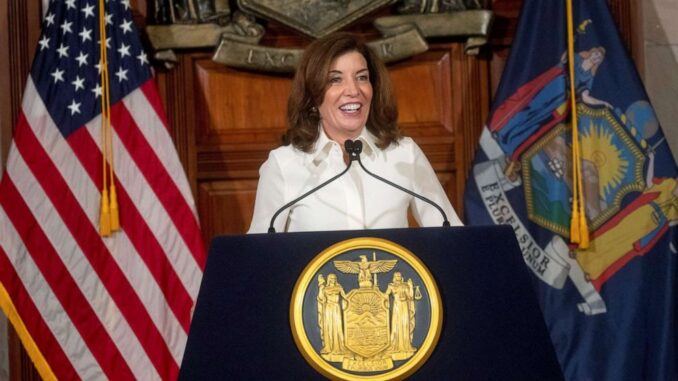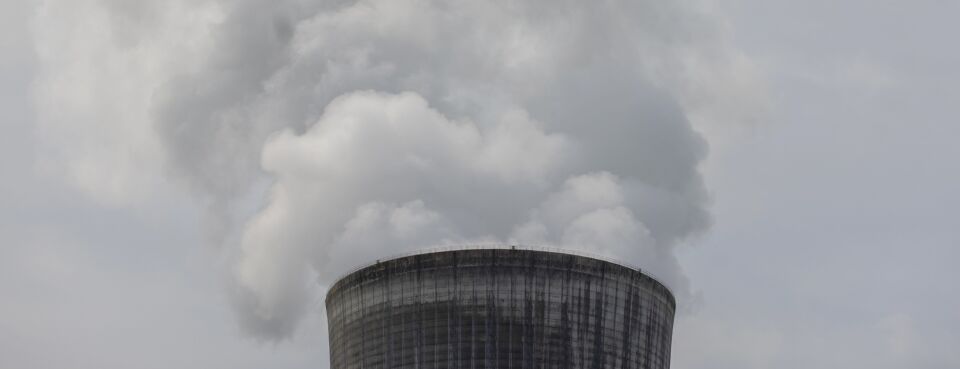

New York regulators will likely miss a statutory deadline for issuing rules that put an ambitious carbon emissions program into effect, but only because they need time to think through how to create an economy-wide plan, according to the state’s top environmental official.
State lawmakers approved the plan, known as cap and invest, as part of the budget process in May. Under the plan, major emitters and companies that distribute heating and transportation fuel will have to buy credits for their emissions. About one-third of the proceeds will go back to New Yorkers to help address energy affordability, and the rest will be spent on investments such as climate change mitigation, energy efficiency, and clean transportation.
The cap-and-invest program is a key part of New York’s plan to deliver on its recent climate bill, which commits the state to 100% zero-emission electricity by 2040. But the rules that enact the program are due by the start of 2024—a goal that will be “very challenging to meet,” Basil Seggos, commissioner of the New York Department of Environmental Conservation, said in an interview.
That’s because the department has to make sure its rules balance multiple goals: they must generate revenue to fund New York’s planned transition to renewable energy, avoid imposing heavy costs on residents, meaningfully cut emissions in disadvantaged communities, and link up with other states so large emitters don’t simply shift their carbon-heavy activities elsewhere, Seggos said.
“We have been nose to the grindstone, and I think we are going to make substantial progress,” Seggos said.
But even relatively straightforward regulations are hard to get done in the one year New York received for its cap and invest rules. Other states with similar programs, including Washington, needed several years to complete them.
In the meantime, Seggos and Gov. Kathy Hochul’s (D) administration find themselves pushed and pulled by environmentalists and Democratic lawmakers who want them to go even further.
For example, Liz Moran, New York policy advocate for Earthjustice, called on Hochul to include in her 2024 state budget the Home Energy Affordable Transition (HEAT) Act—which would strip away a subsidy that foists the cost of new gas hookups onto existing ratepayers, as long as the new customer is within 100 feet of an existing gas main.
Several state lawmakers also want Hochul to include in her budget the Green Transit, Green Jobs Act, which would require public bus systems to switch to zero-emission buses.
“It will be critical to design a strong cap and invest that prioritizes the needs of disadvantaged communities, but it must be coupled with policies in the upcoming state budget that directly cut climate pollution for the state to keep up with its climate law mandates,” Moran said.
Daniel Zarrilli, former New York City Mayor Bill de Blasio’s (D) top policy adviser on climate, said he understands the bind Seggos and his team are in.
“Basil is balancing some very complicated Albany dynamics on cap-and-invest,” said Zarrilli, now special adviser for climate and sustainability at Columbia University. “Getting these rules right is crucial.”
Cost Concerns
Seggos and Hochul found themselves in hot water with the state’s vocal environmental lobby when they proposed this spring to change the way the state counts emissions of the potent greenhouse gas methane.
Under the accounting change Hochul backed, New York would have extended the time frame for measuring methane releases from a 20-year timescale to a 100-year scale. Methane has a shorter life in the atmosphere than carbon dioxide, but is more than 80 times more potent in the first 20 years.
Opponents said the move would have weakened the state’s efforts to hit its climate goals. But Seggos said the idea—which was quickly dropped—was brought forward because the state thought the 20-year timeline would result in unacceptably high energy costs for consumers.
Nevertheless, scratching the plan doesn’t mean the state won’t keep looking for ways to limit costs, Seggos said.
“We’re going to look for ways in which to keep costs down, whether or not that has anything to do with the accounting system,” he said.
Seggos also said he’s open to the idea of banning the purchase of fossil fuel boilers in small buildings, a step that would pair with Hochul’s April action to outlaw fossil fuels in new buildings. New York was the first state in the nation with such a law, but homeowners with gas boilers can still replace their dead units with new gas models.
Given that a boiler lasts about 20 years, the ban—which Hochul has herself supported in previous budgets—is needed to prevent the state from “blowing right into the red zones of higher pollution,” said Pete Sikora, climate and inequality campaigns director at New York Communities for Change.
“We’re going to do everything we can within the programs that we have right now to disincentivize fossil fuel infrastructure,” Seggos said. “That’s my focus right now.”
Leg Up on Implementation
Meanwhile, New York is rolling out its share of the money granted by Congress under the infrastructure and climate bills for states to deploy a wide range of projects, including renewable energy, water infrastructure, and electric vehicle charging stations.
New York has a leg up on other states in implementing projects funded by those laws because “we’re not coming at this brand new,” Seggos said. “We have spent the better part of 10 years creating funding programs to help us achieve our objectives.”
For example, New York already had its own water grant program in place before the infrastructure bill released another $11.7 billion to the federal Drinking Water State Revolving Fund for states and local water systems.
“So when the federal money came about, we already had mechanisms in place,” Seggos said. “We already had a very robust planning document that helped us know where to put funds, and then adapt that program to bring the federal dollars in and apply those dollars to the needs of the state.”
As a case in point, Seggos emphasized the state’s recent approval of $185 million in direct financial aid for water infrastructure projects, $44 million of which came from the federal coffers.
Similarly, New York was able to take $25 million in federal money for plugging legacy oil and gas wells—thousands of which still dot the western part of the state—to augment an existing program, as well as some $14 million to bolster an existing forest conservation program, especially in urban areas, Seggos said.
“Our experience has been positive, and it’s largely because we had a head start in making that evaluation as to what they would need to do,” he said.



